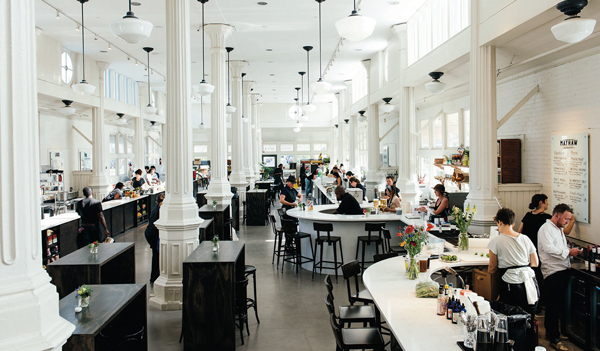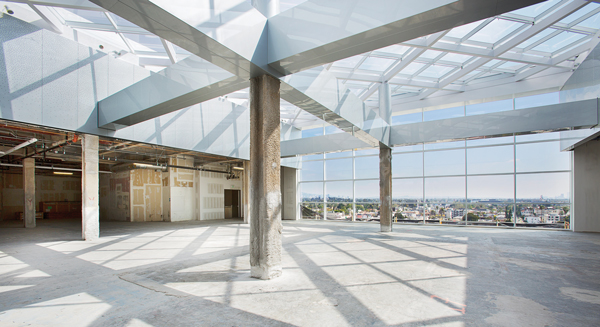Trending
Landlords chow down on eateries
Hip food halls and fast-casual restaurants bring traffic to malls

Restaurants are the new black — black ink, that is.
As more and more shopping centers see red, restaurants are helping them stay on the right side of the ledger.
“Food has become fashion,” Jim Crocenzi of CBRE said. “We’re more conscious about the food we’re eating, and the environment we want to consume it in is more important than ever.”
Restaurants have become the last holdouts for landlords as more shoppers opt for a virtual shopping cart. Scott Acton, chief executive of Las Vegas-based Forté Specialty Contractors, said food gives consumers something they can’t get online — a place to connect: “Food becomes the central point of their gathering.”
Consumers are spending more time dining out, and shopping centers are increasingly adding restaurant concepts from 55,000-square-foot food halls to markets like Eataly to the popular Taiwanese dumpling house Din Tai Fung.
David Pressberg of Kennedy Wilson said that amid the tough retail environment, restaurants are helping to lower vacancy rates for landlords.
New anchors
“A lot of the retailers are kind of dried up and taking a long time to do deals,” Pressberg said. “What we’ve seen is most of the deals getting done and most of the tenants actively looking for real estate are food.”
Millennials’ unrelenting need to photograph their dishes has helped create buzz for many restaurants and drive sales, ultimately making them attractive tenants for many developers and landlords.
Darren Tristano, president of Chicago restaurant research firm Technomic Inc., said restaurants are always a good option for landlords. “Restaurants have certainly driven traffic, and that’s always a good thing,” he said. “What we’ve learned from the millennial generation is that they like going out to eat with greater frequency because it’s part of their lifestyle.”

St. Roch Market, a New Orleans based food hall, is opening a location in Miami’s Design District in early 2018.
Millennials are driving much of the growth, with 18- to-33 year-olds spending about $174 a month on dining out, according to a 2016 study by CBRE Research.
Everything revolves around food these days, according to Matthew Fainchtein of Cushman & Wakefield. One example: Los Angeles shopping mall Westfield Century City. “As we can see with Century City, the new development is predominantly food,” he said. “At least all of the notable or exciting tenants coming to that project are all food-related — Din Tai Fung, Sweetgreen, Shake Shack.”
While some categories such as quick-service restaurants are faring better than others, restaurant analysts expect sales on average to grow steadily over the next year.
Industry sales are predicted to reach $799 billion this year, a 4.3 percent increase compared with sales of $766 billion in 2016, according to the latest research from the National Restaurant Association (NRA).
There is also little sign of a slowdown, as eight in 10 consumers say they’d prefer to spend their leisure time dining out with family and friends rather than cooking, according to the NRA.
“People want to experience all the senses,” Acton said. “I don’t think people go just for food. People go to enjoy themselves and enjoy their company.”
Acton, whose firm completed projects such as chef Michael Mina’s Bardot Brasserie and Carbone at Aria Resort & Casino, said Las Vegas has become a mecca for dining and entertainment, with gambling now playing second fiddle.
It’s a trend he’s noticed on projects across the country and even in places as distant as Macau. “These hoteliers and gaming executives are seeking out the amazing restaurateur to bring a little bit of flavor to different cities,” he said.
Hall pass
One trend helping developers create the ultimate dining experience is the food hall, which brings together several small restaurants and bars under one roof.
“A crazy piece of real estate we’re seeing now is all these food halls in places where they typically wouldn’t place a food hall,” Kennedy Wilson’s Pressberg said.
The European-style food halls are popping up in cities across the country, including Detroit, Nashville, Denver and Atlanta.
The popular Urbanspace food hall in New York City announced last month it will open a second location in Manhattan, joining a slew of others in the city. The 11,400-square-foot space will house 20 food stands across three floors.

Taubman Centers’ $500 million Beverly Center makeover includes a food hall by chef Michael Mina and additional street-level restaurants.
Owners Will Donaldson and Barre Tanguis of New Orleans food hall St. Roch Market announced last month they would be opening a location in Miami’s Design District in early 2018 featuring 12 vendors, as well as an additional location in New Orleans and a possible fourth food hall in Nashville.
Taubman Centers is also beefing up its outdated Beverly Center in Los Angeles with the addition of a food hall. Dubbed “The Street, a Michael Mina Social House,” the project is part of a $500 million mall makeover that would include additional street-level restaurants.
Food halls have become the antidote for filling the thousands of square feet left vacant by shuttered retailers, especially as more store closings are announced.
For instance, teen fashion retailer rue21, headquartered in Warrendale, Pennsylvania, said last month it would close 400 of its 1,100 stores. Bebe Stores, popular for its fitted women’s clothing, planned to close 28 stores in March, but in a regulatory filing last month it disclosed that all of its 169 stores would be closing. And Sears Holdings announced plans to close a combined 150 Kmart and Sears stores in January, with plans to shutter an additional 50 Sears Auto Center locations and 92 pharmacies at Kmart stores.
As trends shift away from huge retail stores, Pressberg said, landlords are starting to find better uses for these spaces.
“Landlords have a 10,000-square-foot vacancy and they realize it’s hard to get a user,” he said. “I can divide my 10,000-square-foot space into smaller 200-square-foot spaces, leasing them out for $10 a foot, and create a food hall similar to Grand Central Market or Edin Park [in Los Angeles].”
Plus, adding a hip new tenant can drive up rents.
“Bringing in a cool restaurant group is going to create a lot of buzz, not only for the project itself but for the submarket, which will in turn cause rents to increase,” Pressberg said.
Throwing off the chains
Christopher Maling of Colliers International said millennials want a quick, cheap and easy option with the freedom to either dine in or carry out.
“Millennials are really trying to break away from the chains and national franchises and look for what’s cool, new and hip, whether it’s craft coffee or the craft burger,” he said. “Getting food into the centers is drawing more traffic, [and] other tenants benefit from that synergy.”
Maling adds that many developers and landlords are also catering to local demographics by signing on specialty restaurants.
Westfield Santa Anita in Arcadia, California, a regional indoor shopping mall, has brought in 16 new stores directly from Asia since 2015. These shops cater to the city’s significant Asian population.
Taiwanese chain Din Tai Fung opened a location there in 2016, as did Uncle Tetsu Japanese Cheesecake, which opened its first U.S. location at the mall.
“Some of these retailers and restaurants we’ve never seen before in the U.S., and they’re thriving,” Maling said.
Tristano of Technomic said consumers are increasingly preferring branded and specialty shops. He pointed to the recent popularity of emerging apparel brands over national chains.
Poke restaurants, serving a raw fish dish popular in Hawaii, food halls and ramen chains are some of this year’s hottest concepts, according to a 2017 study by the NRA. Many diners are sticking to environmentally sustainable concepts, such as restaurants that offer hyperlocal sourcing and chef-driven fast-casual concepts.
Tristano said that looking over the data from the last 15 years shows a huge style shift for consumers. These days, they prefer the convenience of fast-casual restaurants like Blaze Pizza and Shake Shack.
“Fast casual continues to add units,” he said. “For most Americans and lower- to middle-income groups, it’s an affordable place to eat, which is not always the case in full-service.”
Shared plates
Crocenzi of CBRE said the trend of restaurant anchors dates all the way back to 2009, just after the recession.
Developers began allocating more space to food-service tenants to fill excessive vacancies and increase foot traffic. But Crocenzi said it has since grown.
“A regional mall would have 10, maybe 15 percent of their non-department store floor area dedicated to restaurants,” he said. “Now, it’s not uncommon to see that allocation be somewhere between 20 or as high as 40 percent of a shopping center.”
Developers are crafting more creative deal structures to entice hot restaurant tenants into their projects. These include significant concessions with minimum rents and tenant-improvement allowances, according Crocenzi .
“I’m seeing developers be more accommodating and willing to take a little more risk with local and regional restaurateurs, who don’t necessarily have the balance sheet of a larger chain restaurant,” he said.
That’s because millennials are no longer interested in the recognizable national chains, but it’s also a response to where consumers are choosing to spend more of their cash. Restaurant industry sales surpassed grocers’ sales for the first time in history in April 2015, leading to a gap of $1.5 billion between the sectors, according to a 2016 study by CBRE Research.
But Crocenzi said there may be too many plates being served up, and some retail centers have a “glut of restaurants.”
National casual dining chains such as T.G.I. Fridays, Applebee’s and Chili’s are struggling to compete with cheaper and trendier fast-casual chains like Blaze Pizza and Lemonade, a California-based restaurant with a seasonal menu. The restaurant industry also faces rising labor costs and a tough legislative and regulatory landscape, leading insiders to speculate about a slowdown, according to NRA research.
But overall, Pressberg and other insiders expect the industry to remain robust.
“That’s why we’re seeing more restaurant deals get done, especially second-generation space — it just does not sit on the market. Big-box retail is dying, [but] people are always going to be hungry.”




